CADILLAC SEVILLE 1998 4.G Owners Manual
Manufacturer: CADILLAC, Model Year: 1998, Model line: SEVILLE, Model: CADILLAC SEVILLE 1998 4.GPages: 378, PDF Size: 21.99 MB
Page 311 of 378
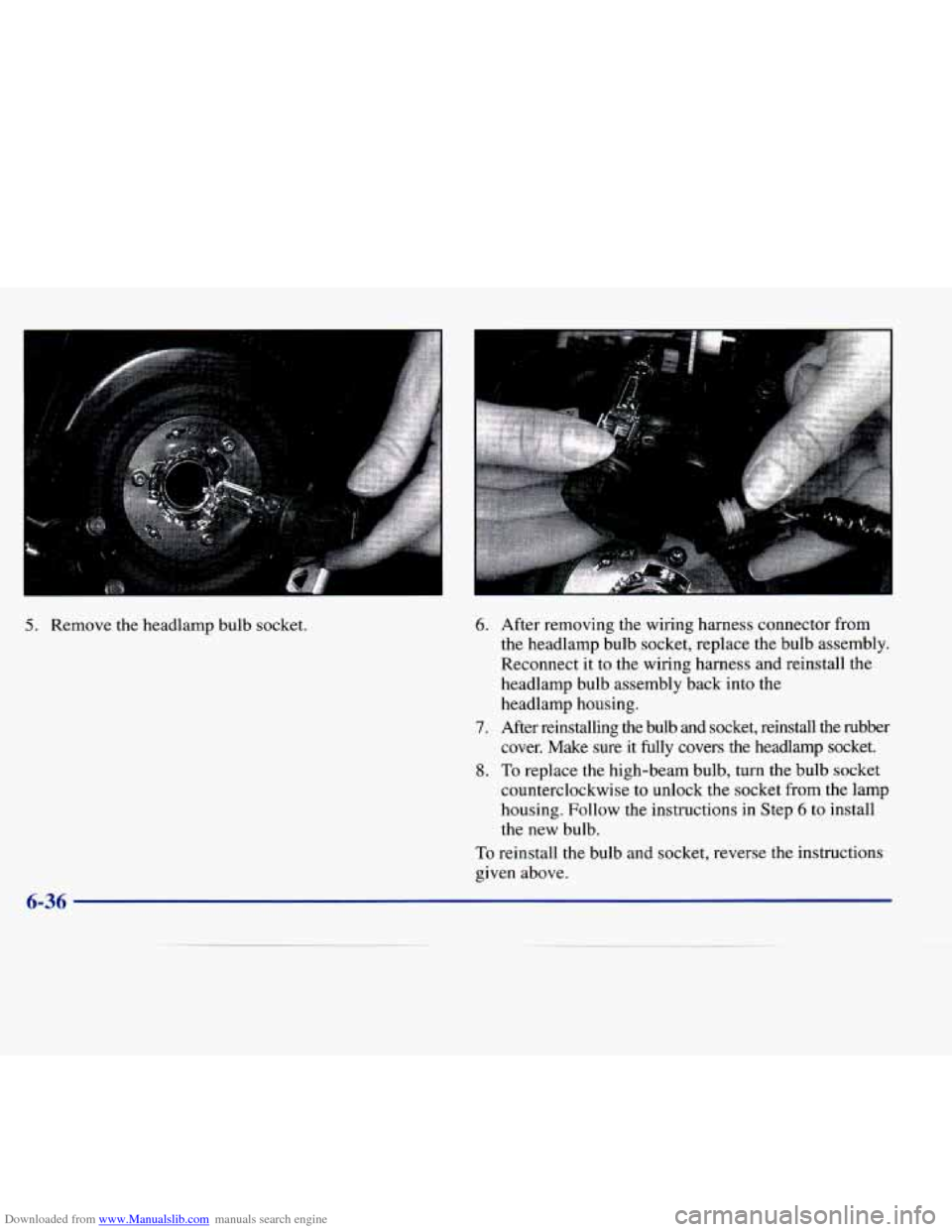
Downloaded from www.Manualslib.com manuals search engine 5. Remove the headlamp bulb socket. 6.
7.
8.
After removing the wiring harness connector from
the headlamp bulb socket, replace the bulb assembly.
Reconnect it to the wiring harness and reinstall the
headlamp bulb assembly back into the
headlamp housing.
After reinstalling the bulb and socket, reinstall the rubber
cover. Make sure it fully covers the headlamp socket.
To replace the high-beam bulb, turn the bulb socket
counterclockwise to unlock the socket from the lamp
housing. Follow the instructions
in Step 6 to install
the new bulb.
To reinstall the bulb and socket, reverse the instructions
given above.
6-36
Page 312 of 378
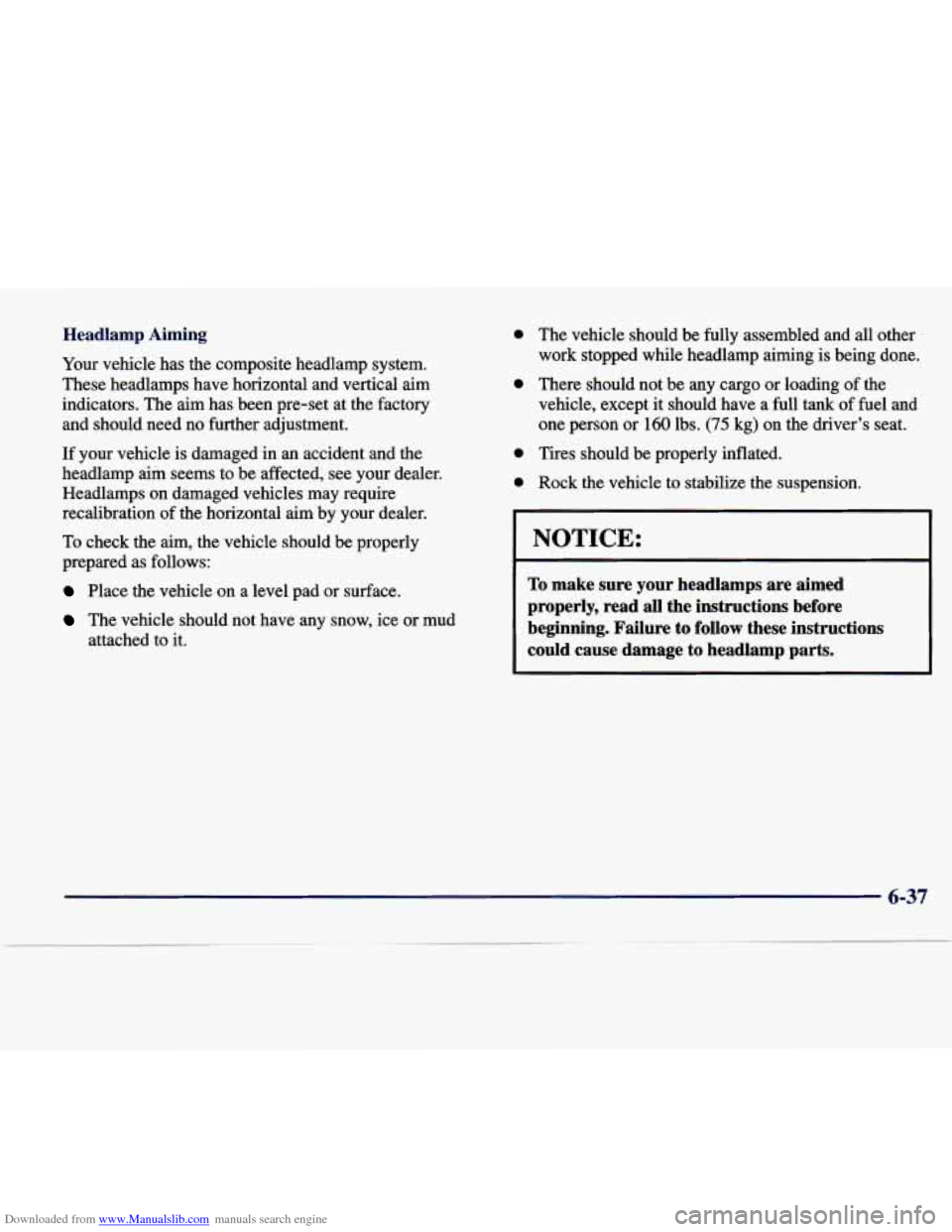
Downloaded from www.Manualslib.com manuals search engine Headlamp Aiming
Your vehicle has the composite headlamp system.
These headlamps have horizontal and vertical aim indicators. The aim has been pre-set at the factory
and should need no further adjustment.
If your vehicle is damaged
in an accident and the
headlamp aim seems to be affected, see your dealer. Headlamps on damaged vehicles may require recalibration of the horizontal aim by your dealer.
To check the aim, the vehicle should be properly
prepared as follows:
Place the vehicle on a level pad or surface.
The vehicle should not have any snow, ice or mud
attached to it.
0
0
0
0
The vehicle should be fully assembled and all other
work stopped while headlamp aiming is being done.
There should not be any cargo or loading
of the
vehicle, except it should have a full tank of fuel and
one person or
160 lbs. (75 kg) on the driver’s seat.
Tires should be properly inflated.
Rock the vehicle to stabilize the suspension.
NOTICE:
To make sure your headlamps are aimed
properly, read all the instructions before
beginning. Failure to follow these instructions
could cause damage to headlamp parts.
Page 313 of 378
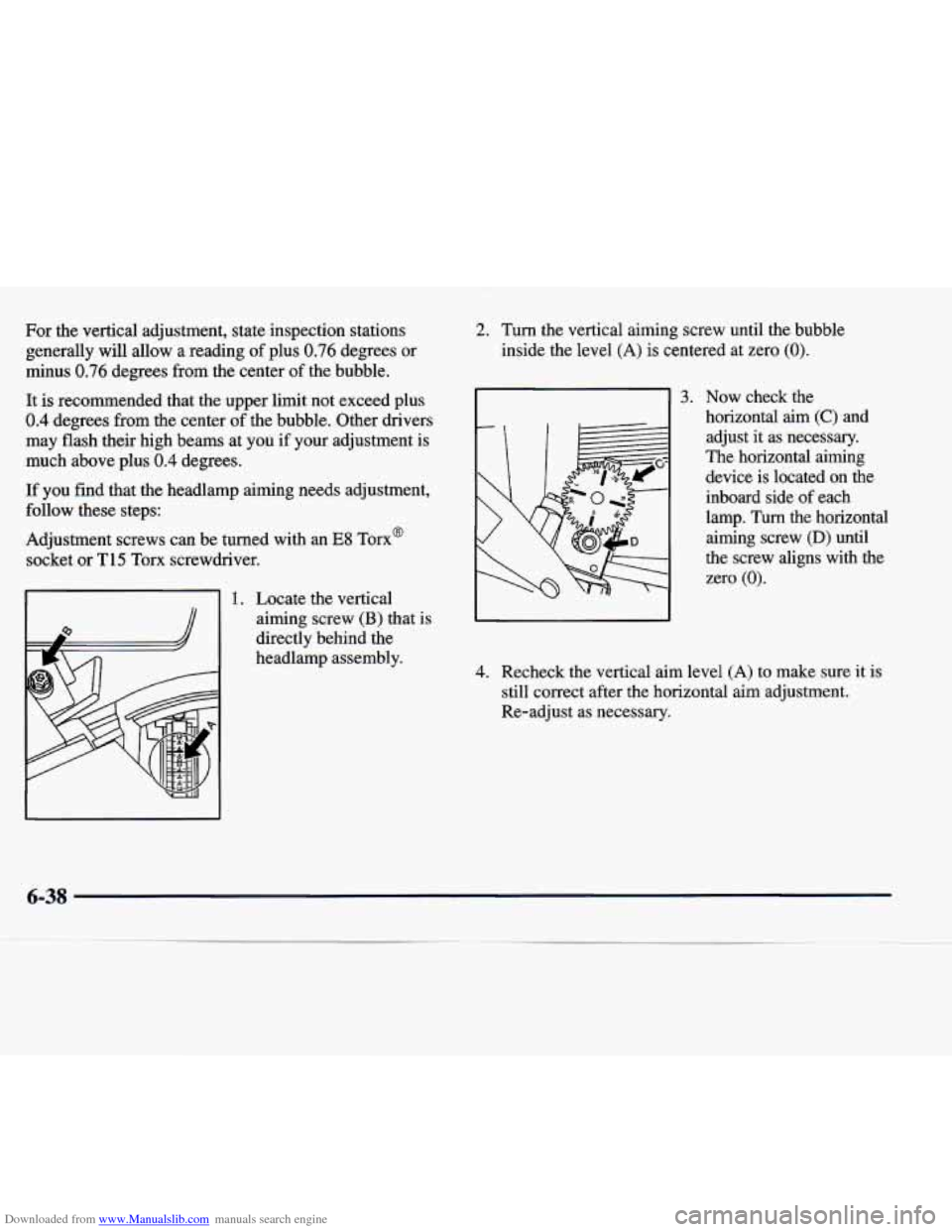
Downloaded from www.Manualslib.com manuals search engine For the vertical adjustment, state inspection stations generally
will allow a reading of plus 0.76 degrees or
minus
0.76 degrees from the center of the bubble.
It is recommended that the upper limit not exceed plus
0.4 degrees from the center of the bubble. Other drivers
may flash their high beams at you
if your adjustment is
much above plus
0.4 degrees.
If you find that the headlamp aiming needs adjustment,
follow these steps:
Adjustment screws can be turned with an
E8 Torx@
socket or
T15 Torx screwdriver.
Ill 1. Locate the vertical
aiming screw
(B) that is
directly behind the
headlamp assembly.
2. Turn the vertical aiming screw until the bubble
inside the level
(A) is centered at zero (0).
3. Now check the horizontal
aim (C) and
adjust it as necessary.
The horizontal aiming
device is located on the
inboard side of each
lamp. Turn the horizontal
aiming screw
(D) until
the screw aligns with the
zero
(0).
4. Recheck the vertical aim level (A) to make sure it is
still correct after the horizontal aim adjustment.
Re-adjust as necessary.
6-38
Page 314 of 378

Downloaded from www.Manualslib.com manuals search engine Front Tlurn Signal Lamps
1. The turn signal lamps are located on the outboard
side of the headlamps. To access, remove the
headlamp,
(see Steps 1,2 and 3 under “Headlamps”).
2. Press the bulb socket tab and turn the bulb socket to
the left to unlock the socket from the lamp housing.
3. To remove the bulb, grasp the socket firmly and pull
the bulb out. Install the new bulb and reverse the
steps
to replace.
Center High-Mounted Stoplamp (CHMSL)
The individual bulbs in the CHMSL are not serviceable.
See your dealer for assistance.
Rear Turn Signal Lamps and Taillamps
1. Open the trunk to gain access to the lamp housing.
2. Remove the rear
compartment sill plate
by removing the upper
convenience net
retainers, located at
each end, as shown.
Move the spare tire cover out
of the way. Pull the trunk
trim away to access the wing nuts.
6-39
Page 315 of 378
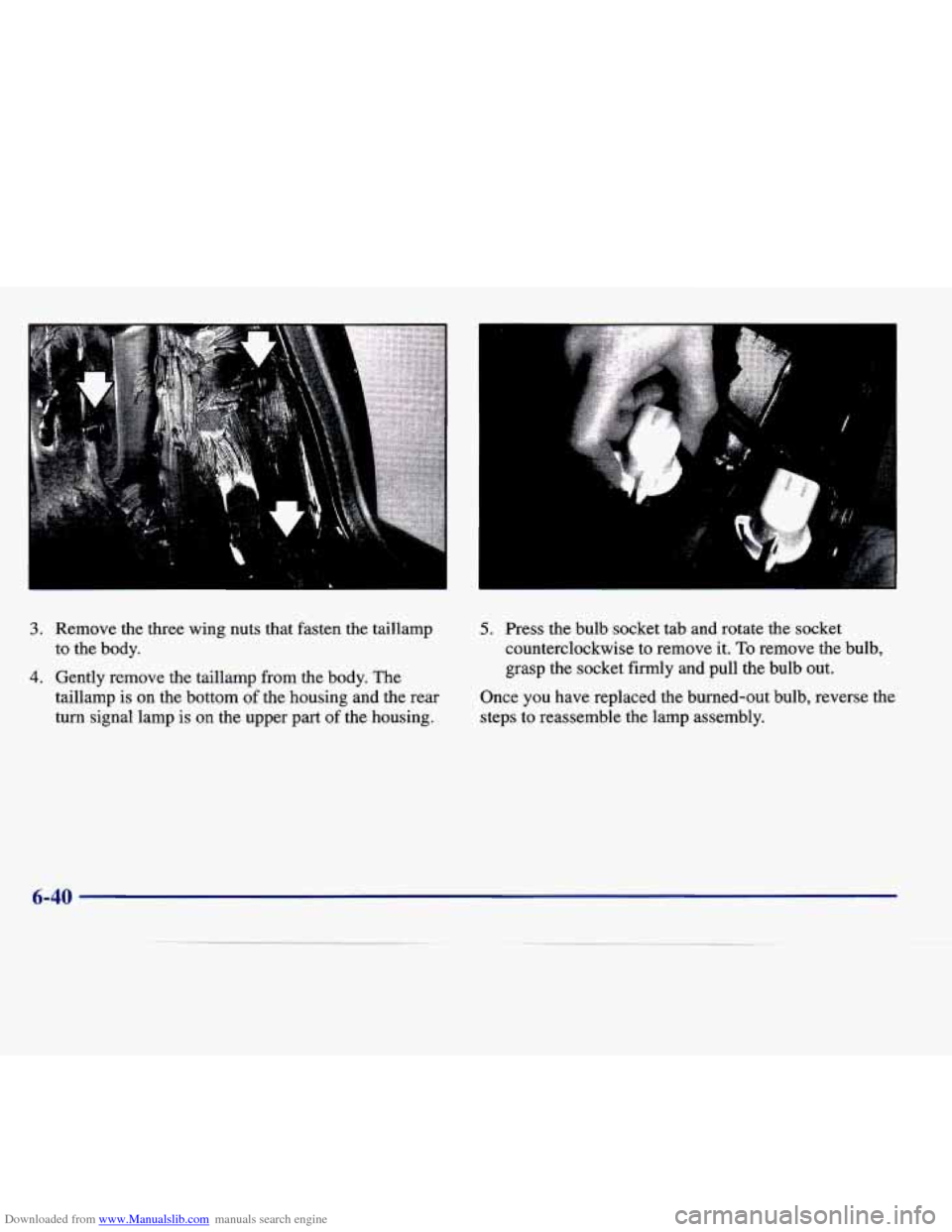
Downloaded from www.Manualslib.com manuals search engine _I
3. Remove the three wing nuts that fasten the taillamp
to the body.
4. Gently remove the taillamp from the body. The
taillamp
is on the bottom of the housing and the rear
turn signal lamp is on the upper part of the housing.
5. Press the bulb socket tab and rotate the socket
counterclockwise to remove it. To remove the bulb,
grasp the socket
firmly and pull the bulb out.
Once you have replaced the burned-out bulb, reverse the
steps to reassemble the lamp assembly.
6-40
Page 316 of 378
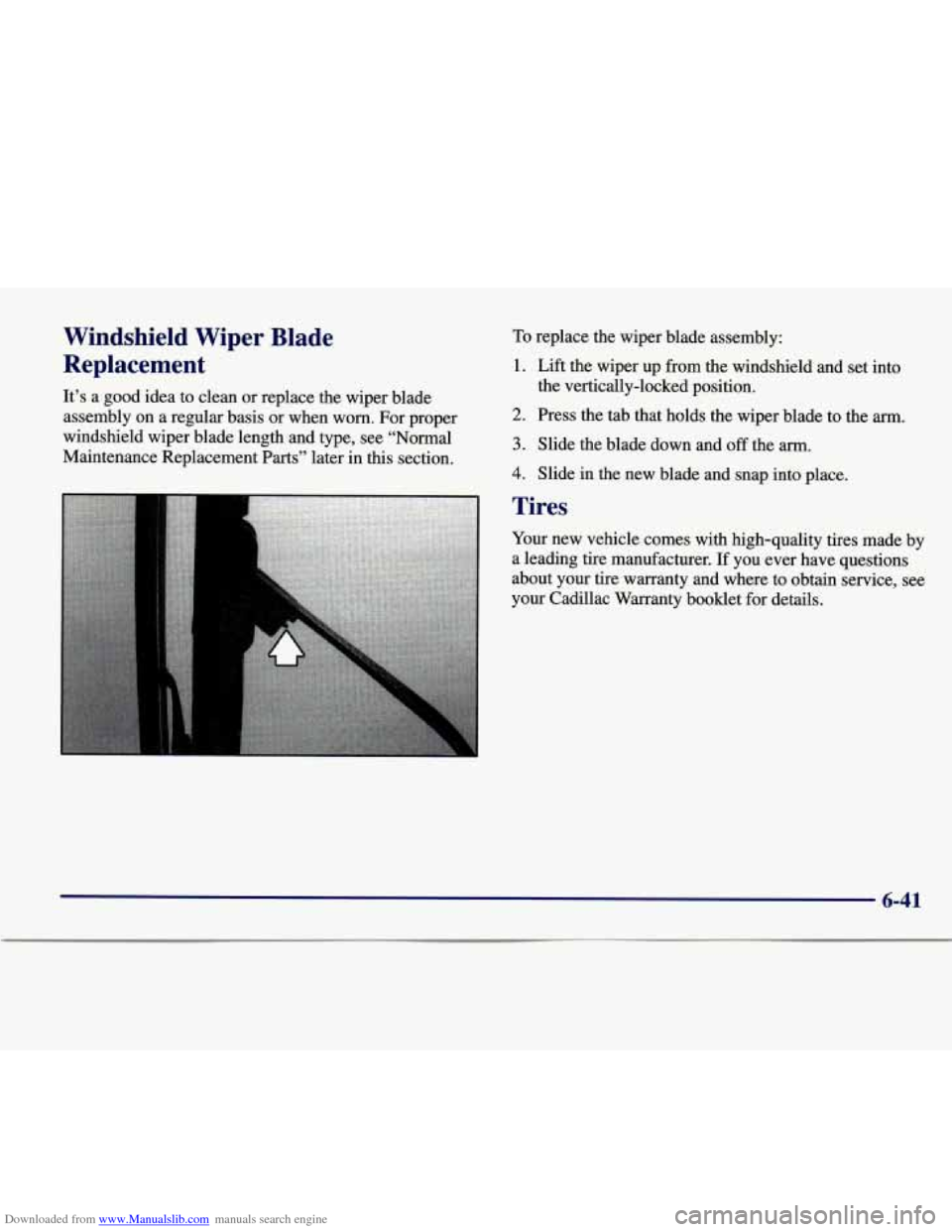
Downloaded from www.Manualslib.com manuals search engine Windshield Wiper Blade -
Replacement
It’s a good idea to clean or replace the wiper blade assembly on a regular basis or when worn. For proper
windshield wiper blade length and type, see “Normal
Maintenance Replacement
Parts” later in this section.
To replace the wiper blade assembly:
1. Lift the wiper up from the windshield and set into
the vertically-locked position.
2. Press the tab that holds the wiper blade to the arm.
3. Slide the blade down and off the arm.
4. Slide in the new blade and snap into place.
Tires
Your new vehicle comes with high-quality tires made by
a leading tire manufacturer.
If you ever have questions
about your tire warranty and where to obtain service, see
your Cadillac Warranty booklet for details.
6-41
Page 317 of 378
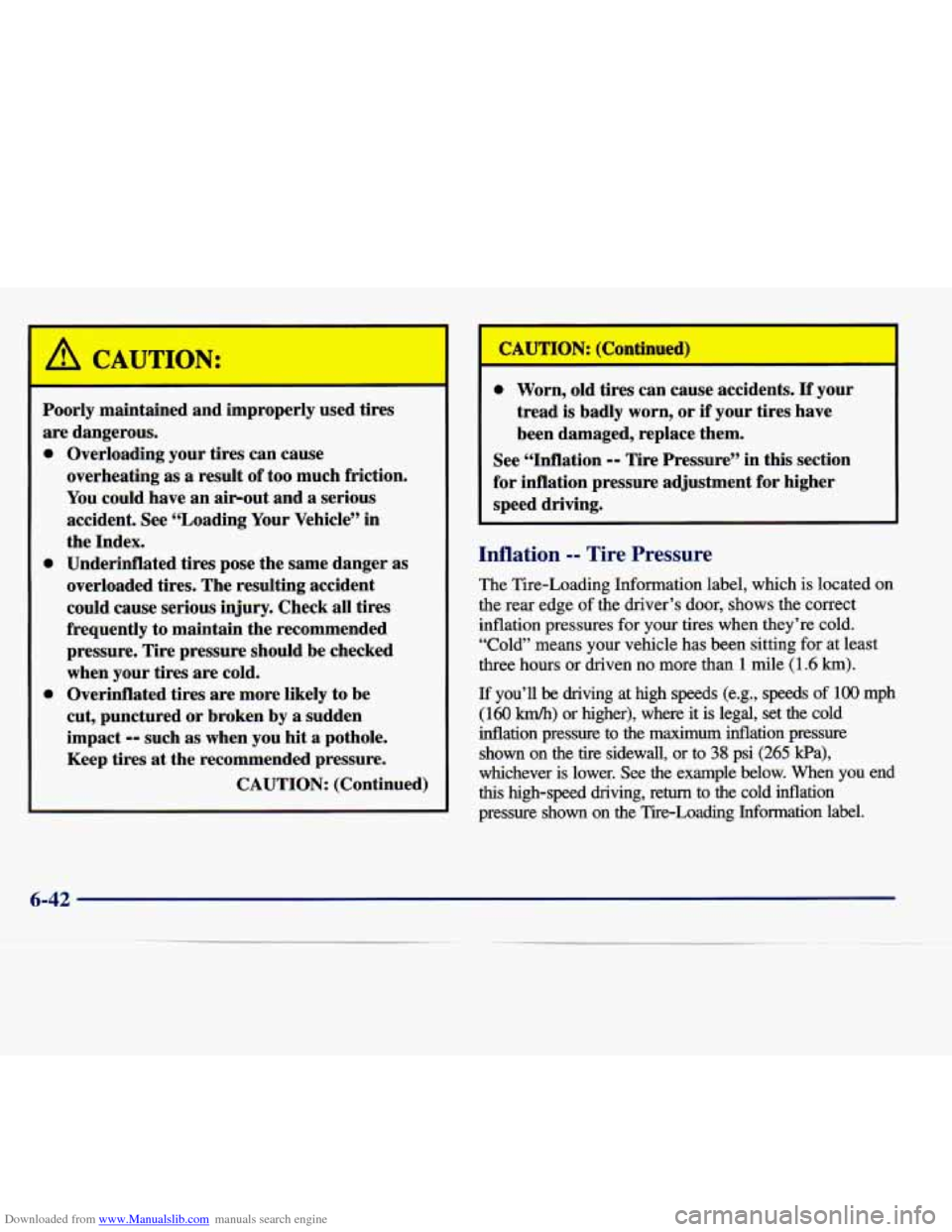
Downloaded from www.Manualslib.com manuals search engine A CAUTION:
Poorly maintained and improperly used tires
are dangerous.
e
e
e
Overloading your tires can cause
overheating as
a result of too much friction.
You could have an air-out and a serious
accident. See “Loading Your Vehicle” in
the Index.
Underinflated tires pose the same danger as
overloaded tires. The resulting accident
could cause serious injury. Check all tires
frequently to maintain the recommended
pressure. Tire pressure should be checked
when your tires are cold.
Overinflated
tires are more likely to be
cut, punctured or broken by
a sudden
impact
-- such as when you hit a pothole.
Keep tires
at the recommended pressure.
CAUTION: (Continued)
I CAUTION: (Continued) I
0 Worn, old tires can cause accidents. If your
tread is badly worn, or if your tires have
been damaged, replace them.
See “Inflation
-- Tire Pressure” in this section
for inflation pressure adjustment for higher
speed driving.
Inflation -- Tire Pressure
The Tire-Loading Information label, which is located an
the rear edge of the driver’s door, shows the correct
inflation pressures
for your tires when they’re cold.
“Cold” means your vehicle has been sitting for at least
three hours or driven no more than
1 mile (1.6 km).
If you’ll be driving at high speeds (e.g., speeds of 100 mph
(160 km/h) or higher), where it is legal, set the cold
inflation pressure to the maximum inflation pressure
shown on the tire sidewall, or to
38 psi (265 Wa),
whichever is lower. See the example below. When you end
this high-speed driving, return to the cold inflation
pressure shown on the Tire-Loading Information label.
6-42
Page 318 of 378
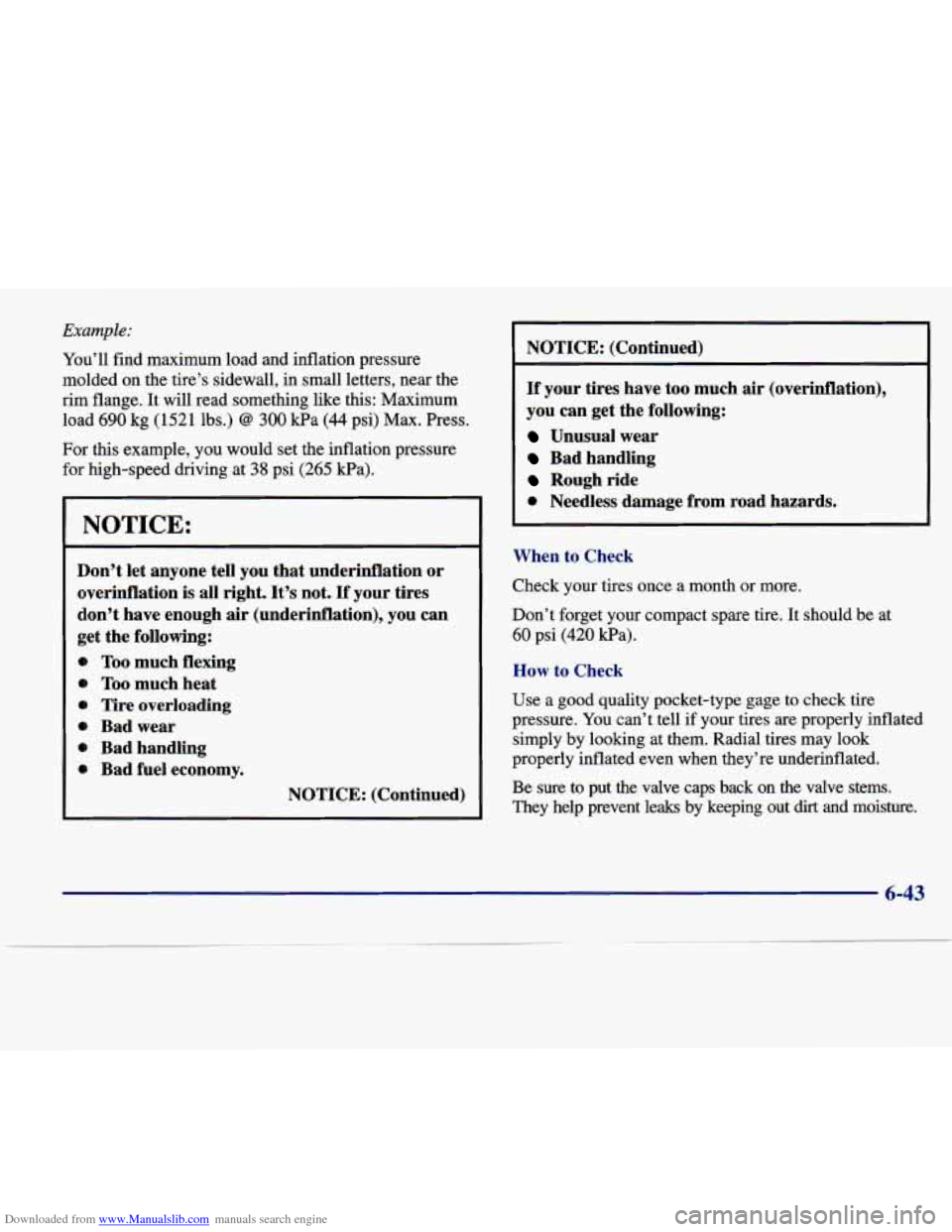
Downloaded from www.Manualslib.com manuals search engine Example:
You’ll find maximum load and inflation pressure
molded on the tire’s sidewall, in small letters, near the
rim flange. It will read something
like this: Maximum
load
690 kg (1521 lbs.) @ 300 kPa (44 psi) Max. Press.
For this example, you would set the inflation pressure
for high-speed driving at
38 psi (265 kPa).
NOTICE:
Don’t let anyone tell you that underinflation or
overinflation is
all right. It’s not. If your tires
don’t have enough
air (underinflation), you can
get the following:
4) Too much flexing
4) Too much heat
4) Tire overloading
Bad wear
Bad handling
a Bad fuel economy.
NOTICE: (Continued)
I NOTICE: (Continued)
If your tires have too much air (overinflation),
you can get the following:
Unusual wear
Bad handling
Rough ride
0 Needless damage from road hazards.
When
to Check
Check your tires once a month or more.
Don’t forget your compact spare tire. It should be at
60 psi (420 Pa).
How to Check
Use a good quality pocket-type gage to check tire
pressure. You can’t
tell if your tires are properly inflated
simply by looking at them. Radial tires may
look
properly inflated even when they’re underinflated.
Be sure to put the valve caps back on the valve stems.
They help prevent leaks by keeping out
dirt and moisture.
6-43
Page 319 of 378
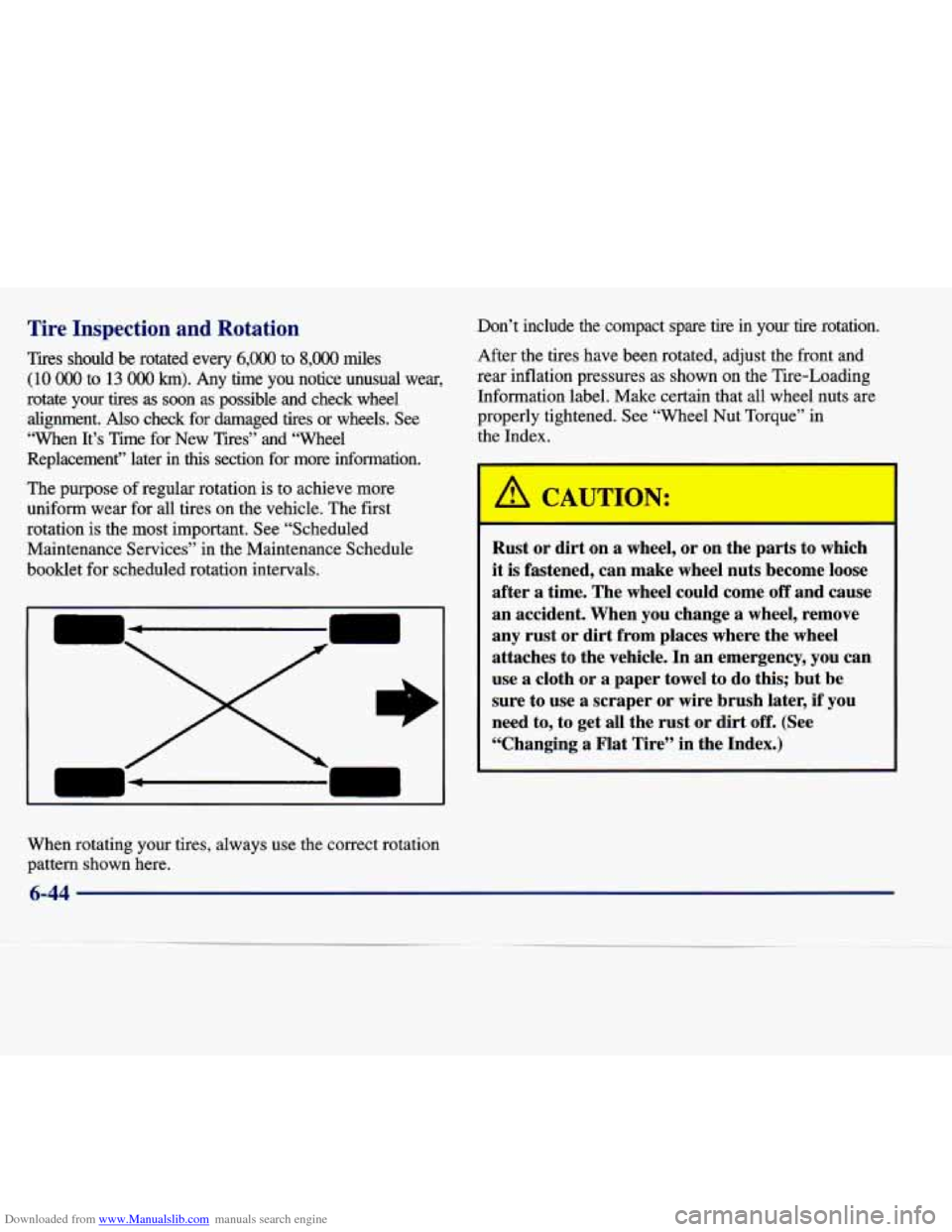
Downloaded from www.Manualslib.com manuals search engine Tire Inspection and Rotation
Tires should be rotated every 6,000 to S,O00 miles
(10 000 to 13 OOO km). Any time you notice unusual wear,
rotate
your tires as soon as possible and check wheel
alignment.
Also check for damaged tires or wheels. See
“When It’s Time for New Tires” and “Wheel
Replacement” later in
this section for more information.
The purpose of regular rotation is to achieve more
uniform wear for all tires on the vehicle. The first
rotation is the most important. See “Scheduled
Maintenance Services” in the Maintenance Schedule
booklet
for scheduled rotation intervals.
When rotating
your tires, always use the correct rotation
pattern shown here. Don’t include the compact spare tire in
your tire rotation.
After the tires have been rotated, adjust the front and
rear inflation pressures as shown on the Tire-Loading Information label. Make certain that all wheel nuts are
properly tightened. See “Wheel Nut Torque” in
the Index.
I
Rust or dirt on a wheel, or on the parts to which
it is fastened, can make wheel nuts become loose
after a time. The wheel could come
off and cause
an accident. When you change
a wheel, remove
any rust or dirt from places where the wheel
attaches to the vehicle. In an emergency, you can
use a cloth or
a paper towel to do this; but be
sure to use
a scraper or wire brush later, if you
need to, to get all the rust or dirt
off. (See
“Changing
a Flat Tire” in the Index.)
1
6-44
Page 320 of 378
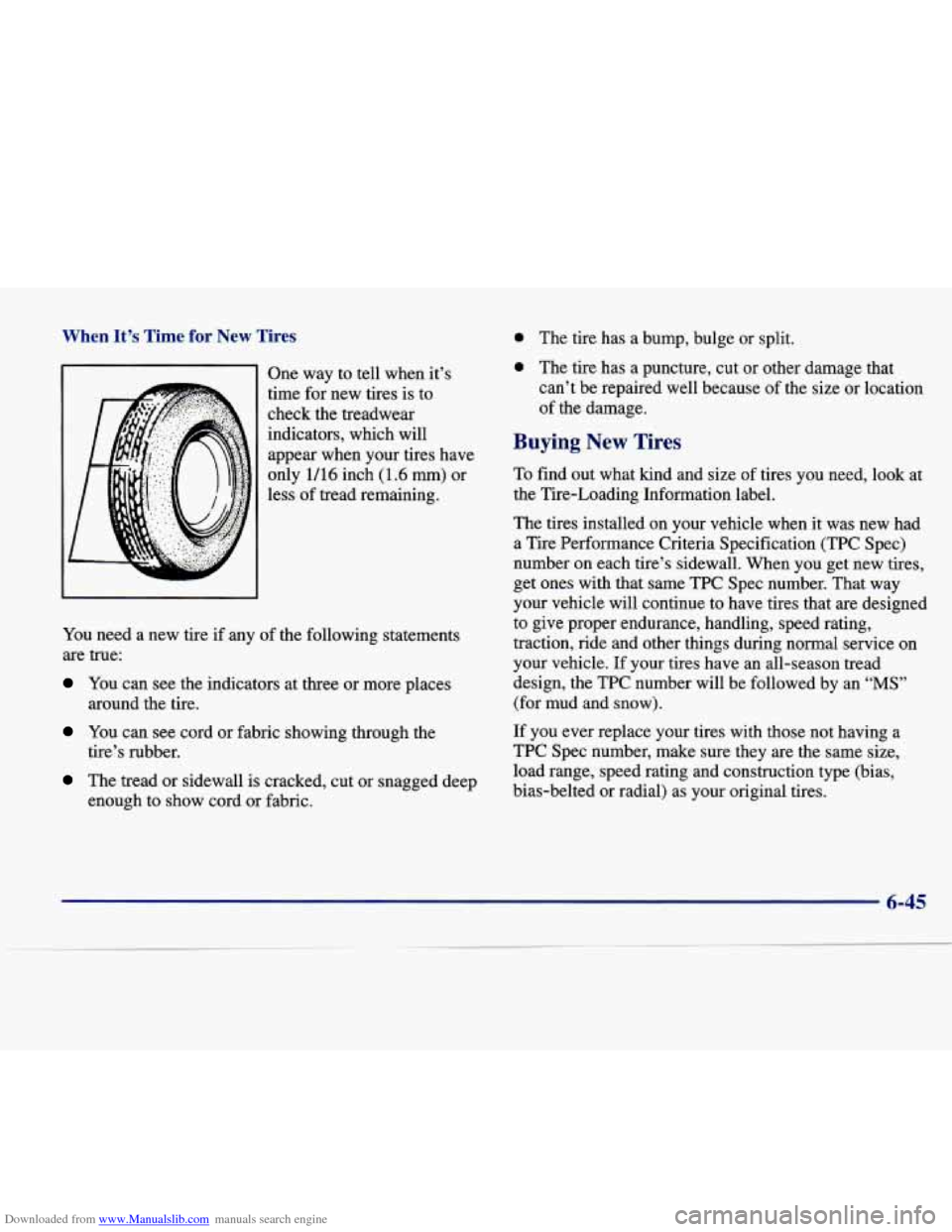
Downloaded from www.Manualslib.com manuals search engine When It’s Time for New Tires
One way to tell when it’s
time for new tires is to
check the treadwear
indicators, which will
appear when your tires have
only
1/16 inch (1.6 mm) or
less of tread remaining.
You need a new tire if any of the following statements
are true:
You can see the indicators at three or more places
around the tire.
You can see cord or fabric showing through the
tire’s rubber.
The tread or sidewall is cracked, cut or snagged deep
enough to show cord or fabric.
0 The tire has a bump, bulge or split.
0 The tire has a puncture, cut or other damage that
can’t be repaired well because of the size or location
of the damage.
Buying New Tires
To find out what kind and size of tires you need, look at
the Tire-Loading Information label.
The tires installed on your vehicle when it was new had
a Tire Performance Criteria Specification (TPC Spec)
number on each tire’s sidewall. When you get new tires,
get ones with that same TPC Spec number. That way
your vehicle will continue to have tires that are designed
to give proper endurance, handling, speed rating,
traction, ride and other things during normal service on
your vehicle. If your tires have an all-season tread
design, the TPC number will be followed by an
“MS”
(for mud and snow).
If you ever replace your tires with those not having a
TPC Spec number, make sure they are the same size,
load range, speed rating and construction type (bias,
bias-belted or radial) as your original tires.
6-45